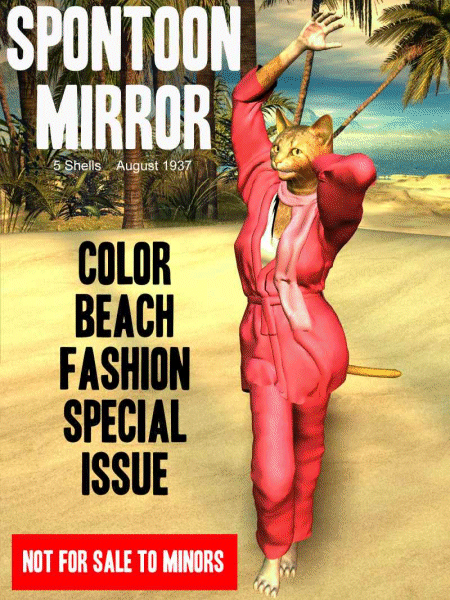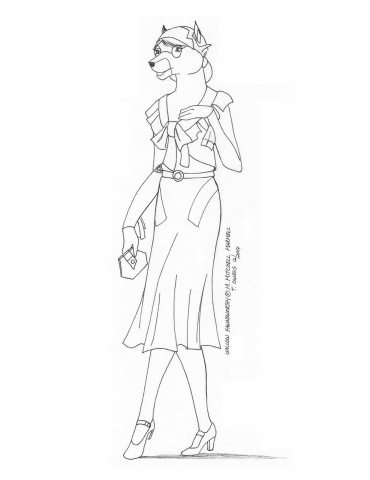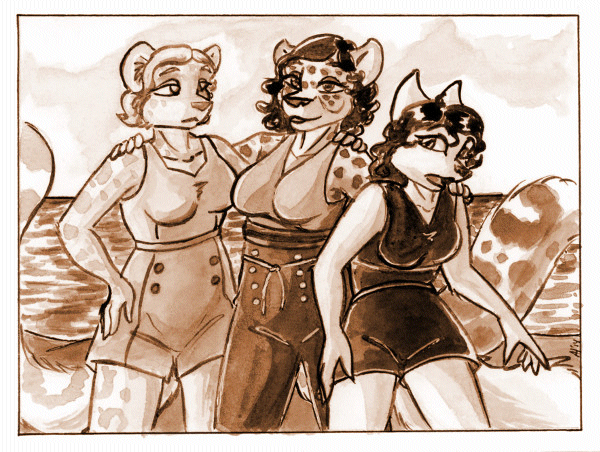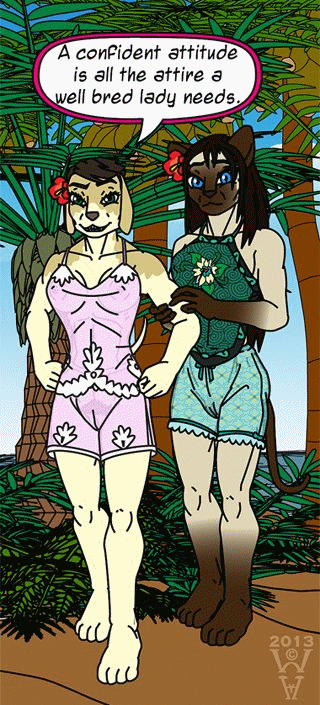|
Spontoon Island
Archipelago
Costume and Clothing Background
(comments by the dazzling
fashion-plate: Ken Fletcher)
The time period shown in the
Spontoon Archipelago is usually in the 1930s, with occasional views
from about 1920 to 1945.
The
variety of costume seen on Spontoon Island can range from fashionable
dress clothing worn by rich tourists to informal token decoration by
subsistence-income islanders. Costume can be for social show or very
pragmatic working clothes.
Tourists & Visitors
Tourists and travelers passing through the Spontoon Islands are for
the most part very rich or civil servants. They can afford to have
traveling clothes shipped in multiple trunks, or perhaps buy clothes
at their destinations. They may wear upper-class formal &
fashionable clothes at special events, entertainments or receptions on
board a tour ship, for example, or at an embassy party. They may also
have packed (or buy) more informal vacation clothes or beachwear.
Fashions from the early 1930s really are from another time: the women's
formal clothes are likely to make your eyes bleed. Men's fashions are
more familiar, but strange in detail. By the late 30s formal costume
for men and women are approaching the standardized late 20th Century
look. However, informal 'vacation' wear can be surprisingly modern in look:
bell-bottom trousers for women's beachwear keep coming back into
fashion through the 30s. Colonial "tropical whites" (& variants)
are always good form for informal tourist wear.
Spontoon Island has tour boats arrive with middle-class (and even
working-class) tourists by the late 1930s. The number of trunks for
clothes is going to be much smaller, and the clothes are going to be
less fashionable -- as if they were selected from a mail-order catalog.
'Euro' residents of the Spontoon Islands
The Spontoon Island Archipelago has a resident population of 'Euros',
concentrated on Casino Island. Only a few of these residents would be
considered rich by European standards, but there is a sizable
professional middle class. Some make a determined effort to stay
fashionable in American, European & Asian style, or at least keep
up that "tropical colonial" look. Many other local Euros have picked up
on the fashion principles of the native Spontoonies, and are more
inclined to "mix-and-match", and pick their clothes for regional
comfort. There are working-class Euros (& beach-combers): Some are
concerned with looking obviously Euro by costume; others enjoy being
able to pass as a Spontoonie when they wish.
Tropical adventure movies of the 1930s are an acceptable guide to some
Euro costume in the Spontoons. The movies of "Indiana Jones" or "King
Kong" are set in this 1930s time period.
Spontoon Archipelago versions of Euro-style fashions
Because the Spontoon Island Archipelago is located in the North
Pacific, and on the other side of the world from fashion centers, one
should not be surprised to see variations on European fashions that
might be 5 to 10 years out-of-date. One can still see "bobbed" hair and
knee-high hemlines. Asian styles of clothes and "Explorer" and
paramilitary fashions can be seen. Sailor & 'Pinafore' leisure wear
is common.
Clothing is influenced by the distance from manufacturing centers and
the costs of shipping raw materials. Affordable clothing & cloth
can come from Asia, as well as England or New England. There are lots
of treadle sewing machines in the archipelago, and a lively trade in
sewing-pattern books.
Hair styles are influenced by the climate: Most of the Spontoon Island
Archipelago is humid, and very warm in the summer tourist season:
"permanent waved" hair doesn't stay permanent.
'Native' Spontoonie fashions -- influences
The Spontoonie culture was deliberately crafted out of a combination of
several cultures from the plantation workers abandoned on the islands
in the 1880s. These even included farm workers from the British Commonwealth, Scandinavians (Icelandic) and North
American natives (Northwest Coast). Polynesian culture has had the most
obvious influence on local clothing, especially as seen by the tourists, and it
admittedly fits the climate and region. (See the History
webpage commentary on the settlement of the islands for more
background)
Spontoon Island native culture is still a work-in-progress, and the
younger Spontoonies grow up with that as part of their culture. They
have a willingness to borrow or combine bits of other cultures, looking
for a good fit for themselves, something that is in tune with what they
are becoming. They are becoming happy with a culture that has a face
for their family and village, a face for all the Spontoonies (the
"Althing", their culture of politics), a face for the resident 'Euro'
population, and a face for the outside 'Euro' world. Sometimes this
face for the outside world is covered with a mask named "Custom".
Their clothing and costume may be changed for each aspect they want to
show.
A family & village may have a preferred style of clothing that may
be comfortable to live and work in around their home. This could be
grass skirts, loincloths, sarongs, or cotton pants & skirts, and
various tops (or not). There might be details or pattern that might
indicate a particular village. Simon Barber has noted the oiled &
brushed patterns & symbols in the fur that can be displayed as
information to other Spontoonies.
A Spontoonie in a political or governmental mood might wear a
costume that indicates an opinion or faction or community job within
the Althing, or perhaps a function within a society -- such as militia
tools or uniform, or a costume style indicating a Spontoonie priestess.
A Spontoonie working with, living with, or dealing with local or
outside Euros is likely to wear a variant on the everyday 1930s generic
"Pacific native" clothing (such as you would be likely to see in
Hawaii): cotton pants or skirt, and a loose shirt or blouse (bright
patterned or light plain cotton, depending on the situation). A sarong
or muu-muu ("Mother Hubbard") might be worn. Shoes or sandals in this
setting. Spontoonies are comfortable with working clothes: A mechanic
would have greasy overalls; a waitress for a tourist cafe might have a
uniform and apron, and might wear them to and from work. The cut of
clothes might be unfashionable by Euro standards, perhaps years out of
date. Most of the time, this generic "Pacific style" is how a
Spontoonie native would appear to a visitor on Casino, Eastern, South,
& Meeting Islands.
Some native Spontoonies, by personal taste or by job situation, may
wear more fashionable 'Euro'-style clothes. This could include formal
suits, summer-weight suits or informal clothes (air conditioning is
very hard to find), 'tropical whites', or a job-based uniform (such as
a Constable or Customs Inspector).
Most Spontoonies are comfortable with more than one daily costume, and
most take great care with their appearance to each other and outsiders.
There is a fair amount of 'solidarity' in offering to brush that stray
flower petal off of your neighbor's shoulder, offering a hair brushing,
and adjusting a lei or a necklace. Clothing or cloth can be a gift to
casual acquaintance, though there seems to be some standard protocol for
graceful returns or alterations, which I have not figured out yet....
Spontoonies can also dress for "Custom". In
fact, many of them enjoy this form of performance art and treat it as an
elaborate co-operative sporting event or masquerade. During tourist
season, a large number of the native Spontoonies create a Polynesian
fantasy version of Spontoon society, complete with assigned role-play
and esoteric costumes. Some of these entertainments are improvised
street theater in tourist areas, some are formal stage shows (dances
& ceremonies) at tourist hotels, some performances are held at
newly constructed 'temples' and 'eldritch ruins' (for discovery by tour
parties led by daring guides), and some are role-play versions of daily
life in fictional Polynesian Spontoonie villages (where guided tour
groups are allowed to visit). After 50 years of development, there are
many traditional roles, with costumes to go with the role. A Spontoonie
'Custom' player might live their role (in costume) for a week or two
out of a tourist season month, and then maybe work on their regular job
for a couple of weeks. Most of the elaborate Polynesian Eclectic
costumes (such as you might see on South Island near the big resort
hotels) would not be Authentic Polynesian or Authentic Spontoonie, but
they are likely to be Authentic 'Spontoon Custom'. But don't get
flippant with that grinning older lady with the tidy grass skirt and
cape flouncing down the hotel stairs: She might really be one of the
Althing Priestesses -- in uniform.
15 June 2006
|




